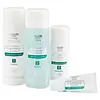What's inside
What's inside
 Key Ingredients
Key Ingredients

 Benefits
Benefits

 Concerns
Concerns

 Ingredients Side-by-side
Ingredients Side-by-side

Allantoin
Skin ConditioningCarbomer
Emulsion StabilisingCeteareth-20
CleansingCetearyl Alcohol
EmollientCyclopentasiloxane
EmollientCyclotetrasiloxane
EmollientDiazolidinyl Urea
PreservativeDimethicone
EmollientEthoxydiglycol
HumectantParfum
MaskingGlyceryl Stearate
EmollientMethylparaben
PreservativePanthenol
Skin ConditioningPEG-100 Stearate
Propylene Glycol
HumectantPropylparaben
PreservativeWater
Skin ConditioningTriethanolamine
BufferingXanthan Gum
EmulsifyingButylene Glycol
HumectantCymbopogon Schoenanthus Extract
Skin ConditioningEthylparaben
PreservativeGeranium Maculatum Extract
TonicGlycereth-26
HumectantHydrated Silica
AbrasiveKaolin
AbrasiveLinoleic Acid
CleansingLinolenic Acid
CleansingMagnesium Aluminum Silicate
AbsorbentMelaleuca Alternifolia Leaf Oil
AntioxidantSodium Lauroyl Sarcosinate
CleansingTitanium Dioxide
Cosmetic ColorantTocopherol
AntioxidantTocopheryl Acetate
AntioxidantZinc Oxide
Cosmetic ColorantAllantoin, Carbomer, Ceteareth-20, Cetearyl Alcohol, Cyclopentasiloxane, Cyclotetrasiloxane, Diazolidinyl Urea, Dimethicone, Ethoxydiglycol, Parfum, Glyceryl Stearate, Methylparaben, Panthenol, PEG-100 Stearate, Propylene Glycol, Propylparaben, Water, Triethanolamine, Xanthan Gum, Butylene Glycol, Cymbopogon Schoenanthus Extract, Ethylparaben, Geranium Maculatum Extract, Glycereth-26, Hydrated Silica, Kaolin, Linoleic Acid, Linolenic Acid, Magnesium Aluminum Silicate, Melaleuca Alternifolia Leaf Oil, Sodium Lauroyl Sarcosinate, Titanium Dioxide, Tocopherol, Tocopheryl Acetate, Zinc Oxide
Benzoyl Peroxide 2.5%
Water
Skin ConditioningCetearyl Alcohol
EmollientCetyl Alcohol
EmollientGlyceryl Stearate
EmollientCocamidopropyl Hydroxysultaine
CleansingSodium C14-16 Olefin Sulfonate
CleansingSodium Methyl Cocoyl Taurate
CleansingCaprylyl Glycol
EmollientCarbomer
Emulsion StabilisingSodium Citrate
BufferingCeteareth-20
CleansingPhenoxyethanol
PreservativeHexylene Glycol
EmulsifyingSodium Hydroxide
BufferingGlycerin
HumectantGlycolic Acid
BufferingDisodium EDTA
Niacinamide
SmoothingCeramide Ng
Skin ConditioningAvena Sativa Kernel Extract
AbrasiveBenzoyl Peroxide 2.5%, Water, Cetearyl Alcohol, Cetyl Alcohol, Glyceryl Stearate, Cocamidopropyl Hydroxysultaine, Sodium C14-16 Olefin Sulfonate, Sodium Methyl Cocoyl Taurate, Caprylyl Glycol, Carbomer, Sodium Citrate, Ceteareth-20, Phenoxyethanol, Hexylene Glycol, Sodium Hydroxide, Glycerin, Glycolic Acid, Disodium EDTA, Niacinamide, Ceramide Ng, Avena Sativa Kernel Extract
 Reviews
Reviews

Ingredients Explained
These ingredients are found in both products.
Ingredients higher up in an ingredient list are typically present in a larger amount.
Carbomer is a polymer of acrylic acid. Its main role is to create a gel consistency.
A high amount of carbomer can cause pilling or balling up of products. Don't worry, most products contain 1% or less of carbomer.
Ceteareth-20 is an emulsifier and cleansing agent. It is derived from cetearyl alcohol, a fatty alcohol.
As an emulsifier, Ceteareth-20 prevents oil and water from separating. It is also a surfactant. Surfactants help gather oil, pollution, and dirt to be washed away.
Cetearyl alcohol is a mixture of two fatty alcohols: cetyl alcohol and stearyl alcohol. It is mainly used as an emulsifier. Emulsifiers help prevent the separation of oils and products. Due to its composition, it can also be used to thicken a product or help create foam.
Cetearyl alcohol is an emollient. Emollients help soothe and hydrate the skin by trapping moisture.
Studies show Cetearyl alcohol is non-toxic and non-irritating. The FDA allows products labeled "alcohol-free" to have fatty alcohols.
This ingredient is usually derived from plant oils such as palm, vegetable, or coconut oils. There is debate on whether this ingredient will cause acne.
Due to the fatty acid base, this ingredient may not be Malassezia folliculitis safe.
Learn more about Cetearyl AlcoholGlyceryl Stearate is a mix of glycerin and stearic acid.
It is used to stabilize the mixing of water and oil ingredients. By preventing these ingredients from separating, it can help elongate shelf life. It can also help thicken the product's texture.
As an emollient, it helps soften skin and supports barrier-replenishing ingredients.
In cosmetics, Glyceryl Stearate is often made from vegetable oils or synthetically produced.
This ingredient may not be fungal-acne safe
Fun fact: The human body also creates Glyceryl Stearate naturally.
Learn more about Glyceryl StearateWater. It's the most common cosmetic ingredient of all. You'll usually see it at the top of ingredient lists, meaning that it makes up the largest part of the product.
So why is it so popular? Water most often acts as a solvent - this means that it helps dissolve other ingredients into the formulation.
You'll also recognize water as that liquid we all need to stay alive. If you see this, drink a glass of water. Stay hydrated!
Learn more about Water